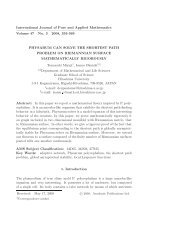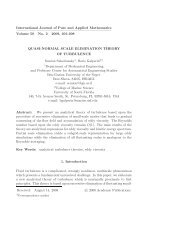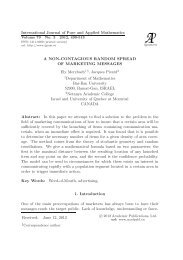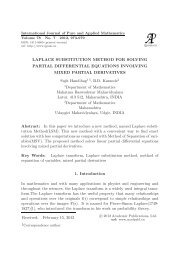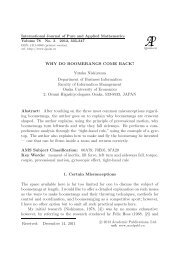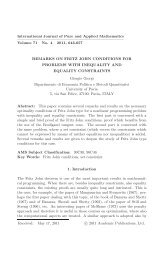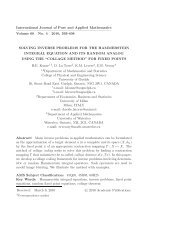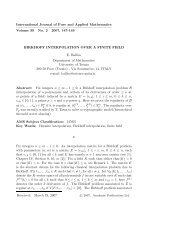FINDING N-TH ROOTS IN NILPOTENT GROUPS AND ...
FINDING N-TH ROOTS IN NILPOTENT GROUPS AND ...
FINDING N-TH ROOTS IN NILPOTENT GROUPS AND ...
Create successful ePaper yourself
Turn your PDF publications into a flip-book with our unique Google optimized e-Paper software.
<strong>F<strong>IN</strong>D<strong>IN</strong>G</strong> N-<strong>TH</strong> <strong>ROOTS</strong> <strong>IN</strong> <strong>NILPOTENT</strong> <strong>GROUPS</strong>... 579<br />
group is torsion-free, it is an R−group. That is, if the n-th root of an element<br />
exists in the Heisenberg group, the root is unique. Therefore, it is possible for<br />
a group to be an R−group but not Černikov complete.<br />
4. Algorithm to find the n-th root in the Nilpotent Group<br />
There is a theorem of Mal’cev that states that every torsion-free nilpotent group<br />
can be embedded in a torsion-free nilpotent group in which every element has<br />
an n-th root for every n ∈ N. For a finitely generated torsion-free nilpotent<br />
group, one way of doing this is by embedding the group in a group of uppertriangular<br />
matrices over Q. We write every element in the form I + N, where<br />
I is the identity matrix and N is a matrix with zeros on and below the main<br />
diagonal. Note that there is an m ∈ Z such that N m = 0. We can then use the<br />
binomial expansion to expand (I + N) 1/n .<br />
4.1. Complexity Analysis<br />
The complexity of finding the n-th root in nilpotent group, lies on the difficulty<br />
of embedding the group into a group of upper-triangular matrices over Q. The<br />
most efficient known algorithm is by Werner Nickel in [13]. As it has been<br />
described in the experimental approach, it suggests it admits exponential time<br />
algorithm.<br />
The algorithm is efficient enough to be able to deal with groups of rather<br />
large Hirsch length. However, the running times obtained appear to increase<br />
exponentially while the dimensions seem to depend polynomially on the Hirsch<br />
length of the group. Presently, we do not have any theoretical bounds on the<br />
dimension of the modules constructed, nor the running time.<br />
Example 4.1. [8] Let T : C n → C n be a linear operator, where T is<br />
multiplication by the Jordan block<br />
⎛<br />
c<br />
⎜<br />
⎜0<br />
⎜<br />
Jn,c = ⎜<br />
⎜.<br />
⎜<br />
⎝.<br />
1<br />
. ..<br />
. ..<br />
0<br />
. ..<br />
. ..<br />
. ..<br />
· · ·<br />
. ..<br />
. ..<br />
. ..<br />
⎞<br />
0<br />
⎟<br />
. ⎟<br />
0⎟<br />
,<br />
⎟<br />
1⎠<br />
0 · · · · · · 0 c<br />
where c = 0. We want to know when there is a linear operator S : C n → C n<br />
such that S 2 = T.



